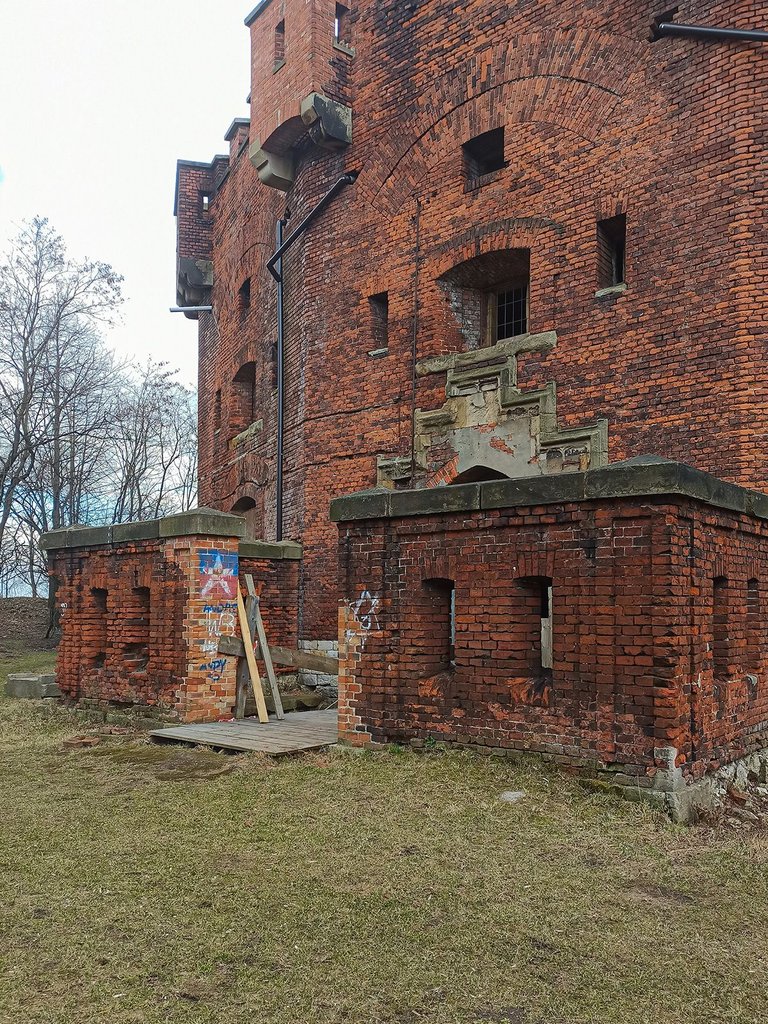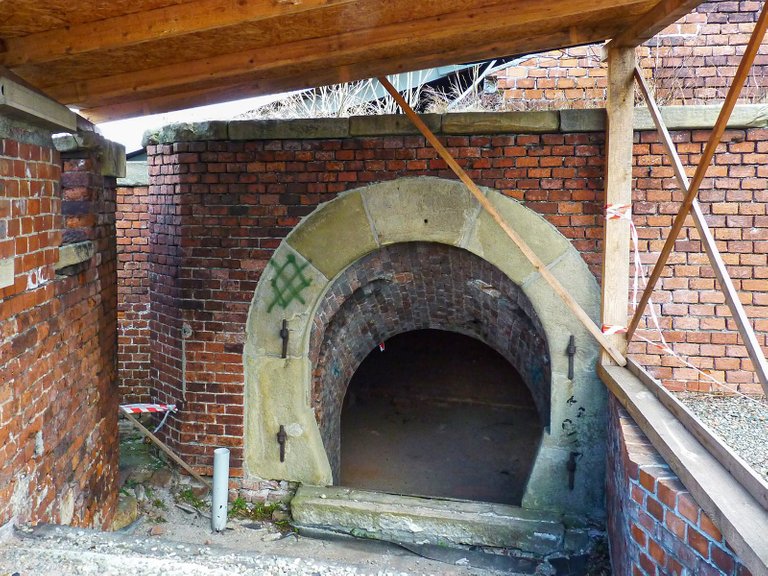Krakow Fortress in the past and today - visit in the interior of Fort Benedict.
Fort Benedict, the only tower fort preserved in Krakow, is unique on a European scale. It is part of the Krakow Fortress, a system of fortifications created by the Austro-Hungarian Empire in the 19th century. More than 100 objects of the fortress have survived to our times. I am a fan of that relics, which is why I quite often write about them :)
Fort Benedict was erected in the mid-nineteenth century on Lasota Hill, next to the small church of St. Benedict. Several high hills surrounded this part of the city (Podgórze), so it was a perfect place for defensive buildings. Therefore, three fortresses were built on the neighboring hills: Benedict, Krakus (built next to the Krakus Mound), and Krzemionki. Only Benedict has survived to our times; the other two were dismantled in the middle of the 20th century.
Although I often visit Lasota Hill, I have never been inside the fort due to its technical condition; you can only see the interior accompanied by a guide. A few weeks ago, I finally managed to join one of the tourist groups. Visiting Benedict (and other buildings of the Krakow Fortress) is organized by the local association Rawelin, which looks after fortification monuments, fights for their restoration, and educates residents. They are true lovers of history, and thanks to this, you can hear many interesting facts and anecdotes during the tour.
In this post, I want to show you what Lasota Hill looks like today and what it looked like 100 years ago. I love watching old photos of my city and imagining how it used to be. All archival images I used in this publication I took from the Polish National Digital Archives (they are available in the public domain). I have put links to the photos at the end of the text.
I recently showed you Lasota Hill, writing about the Podgórze district. The top looks like a vast square - on the left side, you can see a tiny, ancient church of St. Benedict, a 150-year-old tower fort is on the right.

Today, the hill is covered with trees, but it was totally "bald" initially. That's how it looked like in 1926 - then it already started to overgrow.

Let's go back to the present. Although the fort was a military facility, the designers took care of its presentable appearance. The building was to be a showcase of Emperor Franz Joseph, who was the initiator of the construction of the Krakow Fortress.




Let's go inside.
When the fort was in use, the entrance was defended by a multi-stage system: a moat, gates, and a kind of a drawbridge on rollers (it didn't go up but was retractable).


Standing in a tight circular courtyard, I felt as if I was sitting at the bottom of a well.



There were barracks in the fort; it is hard to believe that several hundred soldiers lived here. The number of sleeping places was smaller than the number of soldiers, so they had to share the bunks (while some rested, others performed their duties and then exchanged).
The building uses interesting engineering solutions, such as water circulation using rainwater or gravity ventilation. In some rooms, I could feel the force of fresh air sucked in from outside without the use of devices.



The toilet aroused great interest among the visitors;) Interestingly, even in this room, there was a shooting window!

I was waiting for the most for some exciting views from the top of the fort.




It turned out that the trees obscured most of the panorama. I could see quite a lot anyway - in summer you can hardly see anything beyond the leaves.
I could barely see the outline of the church and buildings in the distance.

And this is the same frame but from 1937. We can see the church of St. Benedict on the edge of the hill and the panorama of Krakow in the background. The silhouette of the Wawel Castle looms on the horizon.

I walked around the accessible part of the roof, looking for any views.

In some places, I was able to see small parts of the city. Here you can see the roof of the Congress Center ICE, on the right side the tower of the modernist Church in Dębniki, and the Kościuszko Mound on the horizon. The mound is surrounded by the well-preserved fort Kościuszko - it is a fantastic place in terms of history and a great vantage point!

I found another gap in the trees - unfortunately, I couldn't see any historic buildings.

On the opposite side, we can see the barely visible silhouette of the Krakus Mound. It is also an essential point on the city map - an ancient mound of mysterious origin. I wrote about it in the article Slavic pyramid or Celtic barrow?

One hundred years ago, there were better views :) In the photo from 1926, we can see the citadel fort Krakus next to the mound, also built by the Austrians in the mid-nineteenth century. Unfortunately, it was demolished in the 20th century.

Finally, two more old shots (the 1930s) with Fort Benedykt and the church. There is a lot of people almost on every archival photo from this place :) It is because they were taken during the annual festivals. Some say that the festival's history goes back to when our ancestors built the Krakus Mound.


Fort Benedict has never taken part in hostilities. After WWII, it housed council flats for some time, then a cultural institution operated here. Now it stands abandoned, and there are still discussions about how to adapt it to serve the inhabitants for the next hundreds of years. May it never have to fulfill its original destiny.


Source of archival photos: National Digital Archives, photos under the CC0 license (Public Domain), links:
https://www.szukajwarchiwach.gov.pl/jednostka/-/jednostka/5895482
https://www.szukajwarchiwach.gov.pl/jednostka/-/jednostka/5970723/obiekty/298023#opis_obiektu
https://www.szukajwarchiwach.gov.pl/jednostka/-/jednostka/5968173/obiekty/331367#opis_obiektu
Congratulations, your post has been added to Pinmapple! 🎉🥳🍍
Did you know you have your own profile map?
And every post has their own map too!
Want to have your post on the map too?
Hiya, @LivingUKTaiwan here, just swinging by to let you know that this post made it into our Top 3 in Daily Travel Digest #1503.
Your post has been manually curated by the @pinmapple team. If you like what we're doing, please drop by to check out all the rest of today's great posts and consider supporting other authors like yourself and us so we can keep the project going!
Become part of our travel community:
Amazing place! Would love to see it one day fully restored and converted in to a museum or art gallery or something that meant it was used and maintained every day!
The gallery is a great idea, and a small cafe on the roof ;)
It's interesting to look at the photos of a place in 100 years ago and now. That's a great idea. People did a great job to maintain the 150-year-old church. It looks like in good condition and its bricks' color is new and bright.
I love such comparisons :)
The fort is over 150 years old, but the church is much older. Its foundations date back to the 11th century, but the building dates from the 16th century and has been renovated several times.
Hi Astin,
thanks for this post. It´s quite fascinating to see the differences between the pictures from 100 years back and today.
Pleasure is mine, I'm glad you like it :)
What a fantastic tour @astinmin. Reading your post was like walking with you as you revealed Fort Benedict's history, culture, as well as its architectural significance. I'm simply glad that the building managed to uphold peace after all these generations regardless of its original mission. 😊
Thank you, I'm glad you took part in my trip 🙂🌼
What a coincidence, I was there today, just a few hours ago! :) Not inside though. Very interesting place, thanks for all the info about it. My pleasure to send some extra support your way.
@tipu curate
Upvoted 👌 (Mana: 23/43) Liquid rewards.
hahaha, Kraków is so small! I won't be surprised we pass each other on the street someday 😅
Thank you 🌼